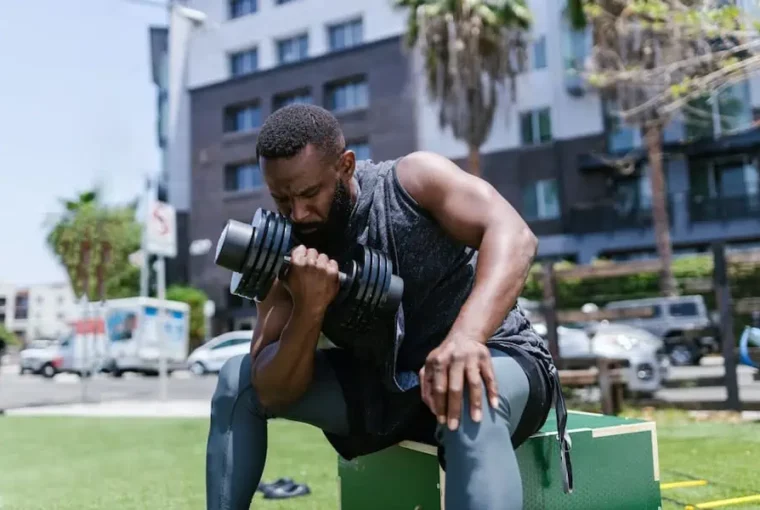Have you ever wondered why bodyweight training is so effective? Why can it be just as beneficial, if not more, than lifting weights or using machines? The answer lies in the science behind it. By leveraging your own body weight and gravity, bodyweight training can help improve strength, flexibility, balance and cardiovascular endurance – all while minimizing the risk of injury.
What Is Bodyweight Training?
Bodyweight training is a type of strength training that uses your own body weight as resistance. It can be done anywhere, at any time, with no equipment needed. You can use your body weight to improve your overall fitness level, lose weight or gain muscle mass.
Bodyweight exercises are a great way to get started with strength training since they require no equipment and can be done anywhere. They’re also a good option for experienced lifters who want to change their routine.
Benefits Of Bodyweight Training
Bodyweight training has a number of benefits for your health. It can help to improve your cardiovascular health, increase muscle strength and endurance, and improve balance and coordination. It can also help to reduce the risk of injuries, improve bone density and promote weight loss.
Exercises To Try
There are many different exercises you can do with bodyweight training. Some of the most popular exercises include push-ups, pull-ups, sit-ups and squats. These exercises can be performed with little to no equipment, making them perfect for home workouts. You can even help yourself, by using Pulley Suspension-Trainer – with a pulley, sling trainers can rotate and alternate movements for a much longer workout.
Push-ups are a great exercise for building upper body strength. They work the chest, shoulders and triceps muscles. To perform a push-up, start in a plank position with your hands placed directly under your shoulders. Lower your body down towards the ground, then push back up to the starting position.
Pull-ups are another excellent exercise for building upper body strength. They target the back and biceps muscles. To perform a pull-up, grab an overhead bar with an overhand grip (palms facing away from you). Pull your body up until your chin clears the bar. Lower back down slowly and repeat.
Sit-ups are a great exercise for strengthening the core muscles (abs and obliques). To perform a sit-up, lie down on your back with your knees bent and feet flat on the ground. Place your hands behind your head or cross them over your chest. Use your abs to curl your torso up off the ground until you’re sitting upright.
Step-By-Step Guide To Building A Workout Routine
If you’re like most people, you probably have a pretty good idea of what a workout routine is. You know that it’s comprised of a series of exercises that are performed in succession and that it’s meant to help improve your overall health and fitness. But do you know the science behind bodyweight training and its impact on health?
The Science Behind Bodyweight Training
Bodyweight training is an effective way to build muscle, lose fat and improve overall fitness. When you perform bodyweight exercises, you’re using your own body weight as resistance. This type of training is often considered to be more functional than weightlifting because it trains your muscles to work together in ways that they would be used in real-world scenarios.
There are many benefits to bodyweight training, including the following:
You can do it anywhere – All you need is your own body weight and some space to move around. You don’t need any special equipment or a gym membership.
It’s affordable – Unlike many other types of exercise, you don’t need to spend any money on equipment or membership fees and you can tailor it to your own fitness level.
Muscle Groups Involved In Bodyweight Exercises
Bodyweight exercises are a great way to get in shape and improve health. But what muscle groups are involved in bodyweight exercises?
There are many different muscle groups involved in bodyweight exercises. The main muscle groups involved are the chest, shoulders, back, arms and legs.
The chest muscles are used in exercises such as push-ups and planks. The shoulder muscles are used in exercises such as overhead presses and dips. The back muscles are used in exercises such as pull-ups and rows. The arm muscles are used in exercises such as push-ups and triceps dips. The leg muscles are used in exercises such as squats and lunges.
Tips For Maximizing Results Of Bodyweight Training
Bodyweight training is a great way to get in shape and improve overall health. However, there are a few things you can do to maximize the results of your bodyweight training. Here are some tips:
- Make sure you are using the proper form. This will help you avoid injuries and get the most out of workouts.
- Use a variety of exercises. This will help keep workouts interesting and challenge your body in different ways.
- Incorporate intense bursts of activity. This will help you burn more calories and fat.
- Make sure you are staying hydrated before, during and after workouts. This will help your body recover properly and be better prepared for future workouts.
Alternative Activities To Consider
If you’re looking to mix up your workout routine, there are plenty of alternative activities to consider that can still provide great health benefits. Try swimming laps at the pool, taking a yoga or Pilates class, going for a hike or bike ride outdoors, or even trying out a new sport.
Conclusion
Bodyweight training can be an effective form of exercise for improving physical and mental health. This type of training has many benefits, from improved strength, endurance, flexibility, and balance to better posture and fat loss.
It’s important to remember that with any type of exercise program, it is important to use the correct form when exercising in order to protect yourself from injury. Incorporating bodyweight exercises into workout routines will help you reach fitness goals in a safe and efficient manner.




